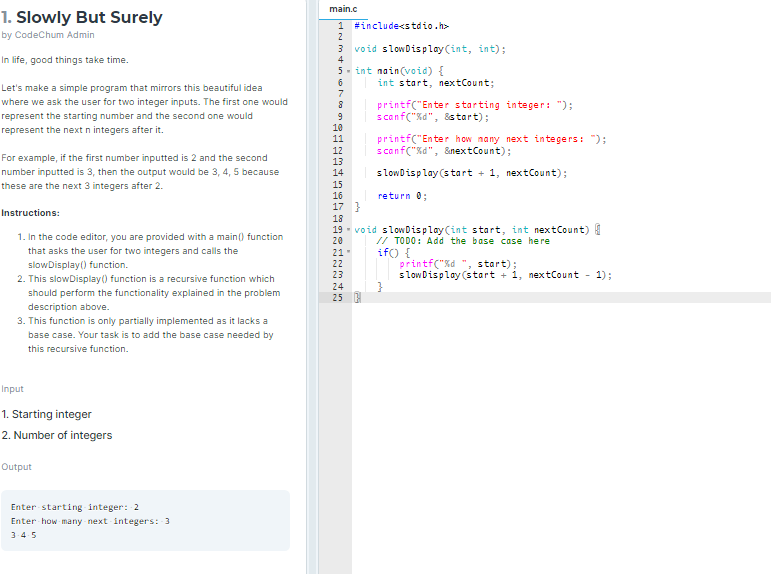In C Language please.. Let's make a simple program that mirrors this beautiful idea where we ask the user for two integer inputs. The first one would represent the starting number and the second one would represent the next n integers after it. For example, if the first number inputted is 2 and the second number inputted is 3, then the output would be 3, 4, 5 because these are the next 3 integers after 2. Instructions: In the code editor, you are provided with a main() function that asks the user for two integers and calls the slowDisplay() function. This slowDisplay() function is a recursive function which should perform the functionality explained in the problem description above. This function is only partially implemented as it lacks a base case. Your task is to add the base case needed by this recursive function. Input 1. Starting integer 2. Number of integers Output Enter starting integer: 2 Enter how many next integers: 3 3 4 5
Operations
In mathematics and computer science, an operation is an event that is carried out to satisfy a given task. Basic operations of a computer system are input, processing, output, storage, and control.
Basic Operators
An operator is a symbol that indicates an operation to be performed. We are familiar with operators in mathematics; operators used in computer programming are—in many ways—similar to mathematical operators.
Division Operator
We all learnt about division—and the division operator—in school. You probably know of both these symbols as representing division:
Modulus Operator
Modulus can be represented either as (mod or modulo) in computing operation. Modulus comes under arithmetic operations. Any number or variable which produces absolute value is modulus functionality. Magnitude of any function is totally changed by modulo operator as it changes even negative value to positive.
Operators
In the realm of programming, operators refer to the symbols that perform some function. They are tasked with instructing the compiler on the type of action that needs to be performed on the values passed as operands. Operators can be used in mathematical formulas and equations. In programming languages like Python, C, and Java, a variety of operators are defined.
In C Language please..
Let's make a simple program that mirrors this beautiful idea where we ask the user for two integer inputs. The first one would represent the starting number and the second one would represent the next n integers after it.
For example, if the first number inputted is 2 and the second number inputted is 3, then the output would be 3, 4, 5 because these are the next 3 integers after 2.
Instructions:
- In the code editor, you are provided with a main() function that asks the user for two integers and calls the slowDisplay() function.
- This slowDisplay() function is a recursive function which should perform the functionality explained in the problem description above.
- This function is only partially implemented as it lacks a base case. Your task is to add the base case needed by this recursive function.
Input
1. Starting integer
2. Number of integers
Output

Step by step
Solved in 4 steps with 2 images









